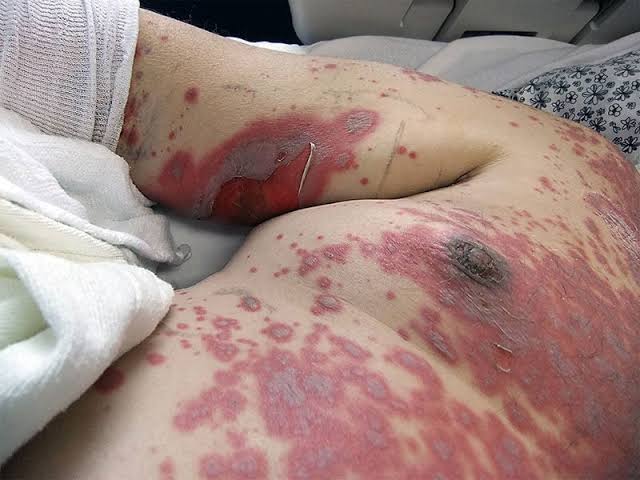How to get rid of stretch marks?;

Stretch marks, medically known as striae, are a common skin condition characterized by visible streaks or lines on the skin’s surface. They often appear as slightly indented, discolored bands and can occur anywhere on the body, although they most commonly affect areas prone to rapid growth or weight gain, such as the abdomen, thighs, hips, buttocks, and breasts. While stretch marks themselves are harmless and pose no health risks, they can be a source of self-consciousness and insecurity for many individuals. Fortunately, there are numerous effective methods available to diminish their appearance and restore smooth, flawless skin.
How to get rid of stretch marks?
1. Exfoliation: Slough Away the Stripes
Exfoliation is a fundamental step in any skincare routine, and it can be particularly beneficial for reducing the visibility of stretch marks. By gently removing dead skin cells from the surface of the skin, exfoliation promotes cell turnover and encourages the growth of new, healthy skin cells, ultimately diminishing the appearance of stretch marks over time.
Why Exfoliation Matters:
Exfoliation helps to smooth out the skin’s texture and improve its overall appearance. By eliminating dead skin cells and encouraging cell renewal, exfoliation can make stretch marks appear less noticeable and promote a more even skin tone.
Choosing the Right Exfoliants:
When selecting exfoliating products for stretch mark removal, it’s important to choose gentle formulations that won’t irritate or damage the skin. Look for exfoliants containing ingredients such as glycolic acid, salicylic acid, or retinol, which are known for their effectiveness in promoting skin renewal and reducing the appearance of scars and imperfections.
How to Incorporate Exfoliation into Your Routine:
For best results, incorporate exfoliation into your skincare routine 2-3 times per week. Begin by cleansing the skin to remove any dirt, oil, or impurities, then apply the exfoliating product to the affected areas using gentle, circular motions. Be sure to follow up with a moisturizer to replenish lost hydration and keep the skin soft and supple.
2. Moisturization: Hydrate for Smooth Skin
Moisturization plays a crucial role in maintaining healthy, youthful-looking skin and can also help to reduce the appearance of stretch marks. Keeping the skin well-hydrated helps to improve its elasticity and flexibility, making it less prone to the formation of new stretch marks and aiding in the fading of existing ones.
The Importance of Moisturization:
Dry, dehydrated skin is more susceptible to developing stretch marks, as it lacks the elasticity needed to accommodate rapid changes in size or shape. By keeping the skin moisturized and hydrated, you can help to prevent the formation of new stretch marks and minimize the visibility of existing ones.
Key Ingredients for Hydration:
When choosing a moisturizer for stretch mark removal, opt for formulations that are rich in hydrating ingredients such as cocoa butter, shea butter, or vitamin E. These ingredients help to nourish and moisturize the skin, improving its texture and appearance over time.
Tips for Effective Moisturization:
To maximize the benefits of moisturization, apply your chosen moisturizer liberally to the affected areas immediately after showering or bathing, when the skin is still damp. This helps to lock in moisture and keep the skin hydrated throughout the day. Additionally, consider using a moisturizer specifically formulated for stretch marks, as these products often contain additional ingredients designed to target and diminish the appearance of scars and imperfections.
3. Targeted Treatments: Boost Your Skincare Arsenal
In addition to exfoliation and moisturization, targeted treatments can provide an extra boost in the fight against stretch marks. These treatments often contain specialized ingredients that help to improve skin elasticity, promote collagen production, and fade discoloration, resulting in smoother, more even-toned skin.
Understanding Targeted Treatments:
Targeted treatments for stretch marks come in various forms, including creams, serums, oils, and gels. These products typically contain ingredients such as hyaluronic acid, collagen, peptides, and vitamin C, all of which have been shown to be effective in reducing the appearance of stretch marks and promoting skin health.
Effective Ingredients to Look For:
When choosing a targeted treatment for stretch mark removal, look for products that contain clinically proven ingredients known for their skin-renewing and collagen-boosting properties. Hyaluronic acid helps to hydrate and plump the skin, reducing the appearance of fine lines and wrinkles, while collagen and peptides work to improve skin elasticity and firmness, resulting in smoother, more resilient skin.
Integration into Your Skincare Regimen:
To incorporate targeted treatments into your skincare routine, apply the product to the affected areas following exfoliation and moisturization. Massage the treatment into the skin using gentle, circular motions, ensuring thorough coverage of the stretch marks. For best results, use the treatment consistently as directed, and be patient, as it may take several weeks or months to see noticeable improvement.
4. Dermatological Procedures: Professional Solutions
For those seeking more intensive solutions for stretch mark removal, dermatological procedures offer effective options for achieving smoother, more even-toned skin. These procedures are performed by trained professionals and can help to significantly reduce the appearance of stretch marks by stimulating collagen production, promoting skin renewal, and improving overall skin texture.
Exploring Dermatological Options:
Dermatological procedures for stretch mark removal include laser therapy, microdermabrasion, chemical peels, and microneedling, among others. These treatments work by targeting the underlying layers of the skin, stimulating collagen production, and promoting the growth of new, healthy skin cells, resulting in smoother, more evenly toned skin.
Common Procedures for Stretch Mark Removal:
Laser therapy is one of the most popular and effective treatments for stretch mark removal, as it can target specific areas of the skin with precision, minimizing damage to surrounding tissues. During laser therapy, a specialized laser is used to deliver concentrated beams of light to the affected areas, stimulating collagen production and promoting skin renewal.
Microdermabrasion and chemical peels are other popular dermatological procedures for stretch mark removal, both of which work by exfoliating the outermost layer of the skin and promoting cell turnover. Microneedling, on the other hand, involves the use of a specialized device equipped with tiny needles that create micro-injuries in the skin, triggering the body’s natural healing response and promoting the growth of new, healthy skin cells.
Considerations and Consultations:
Before undergoing any dermatological procedure for stretch mark removal, it’s essential to consult with a qualified dermatologist or skincare professional to discuss your options and determine the most suitable treatment plan for your individual needs. Be sure to ask questions, voice any concerns or reservations you may have, and follow your provider’s recommendations for pre and post-treatment care to ensure optimal results.
5. Lifestyle Factors: Supporting Skin Health from Within
In addition to topical treatments and dermatological procedures, maintaining a healthy lifestyle can also play a significant role in preventing and reducing the appearance of stretch marks. By adopting healthy habits and making positive lifestyle choices, you can support your skin’s natural healing process and promote overall skin health from within.
The Role of Lifestyle in Stretch Mark Prevention:
A balanced diet, regular exercise, adequate hydration, and proper skincare are all essential components of a holistic approach to
skincare that can help prevent stretch marks from forming and support the effectiveness of topical treatments and dermatological procedures in reducing their appearance.
Nutrition: Feeding Your Skin:
A diet rich in vitamins, minerals, and antioxidants is essential for maintaining healthy skin and supporting its natural repair processes. Foods high in vitamin C, vitamin E, zinc, and collagen-boosting nutrients like protein and amino acids can help promote skin elasticity and resilience, reducing the likelihood of stretch marks forming. Incorporate plenty of fruits, vegetables, lean proteins, whole grains, and healthy fats into your diet to nourish your skin from the inside out.
Exercise: Boosting Circulation:
Regular physical activity not only helps to maintain a healthy weight and promote overall well-being but also plays a role in improving circulation and blood flow to the skin. Increased blood flow delivers essential nutrients and oxygen to the skin cells, promoting cell renewal and enhancing skin health. Aim for at least 30 minutes of moderate-intensity exercise most days of the week to reap the benefits for your skin and overall health.
Hydration: Essential for Skin Elasticity:
Proper hydration is crucial for maintaining skin elasticity and preventing dryness, which can contribute to the formation of stretch marks. Aim to drink plenty of water throughout the day to keep your skin hydrated from the inside out. Additionally, consider using a hydrating moisturizer to lock in moisture and prevent moisture loss, especially in areas prone to stretch marks.
Sun Protection: Shielding Your Skin:
Exposure to ultraviolet (UV) radiation from the sun can damage the skin’s collagen and elastin fibers, making it more susceptible to stretch marks and other signs of aging. Protect your skin from harmful UV rays by wearing sunscreen with a broad-spectrum SPF of 30 or higher every day, even on cloudy days or during the winter months. Additionally, seek shade, wear protective clothing, and avoid prolonged sun exposure, especially during peak hours when the sun’s rays are strongest.
Stress Management: Minimizing Cortisol Levels:
Chronic stress can wreak havoc on the body’s hormonal balance, leading to increased levels of cortisol, a hormone associated with weight gain, inflammation, and decreased skin elasticity. Practice stress-reducing techniques such as mindfulness meditation, deep breathing exercises, yoga, or spending time in nature to help lower cortisol levels and promote overall skin health.
6. How to get rid of stretch marks? Summary:
In conclusion, while stretch marks may seem like a stubborn nuisance, they are not invincible. By incorporating a combination of exfoliation, moisturization, targeted treatments, and possibly dermatological procedures into your skincare routine, along with adopting a healthy lifestyle and making positive lifestyle choices, you can effectively reduce the appearance of stretch marks and achieve smoother, more even-toned skin. Remember, consistency, patience, and persistence are key on the journey to achieving your desired results. With dedication and a comprehensive approach to skincare, you can say goodbye to stretch marks and hello to smooth, flawless skin once again.
Read another article:

